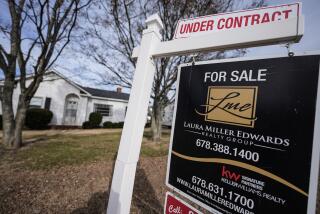It Pays to Check ARM Interest Rate Changes : Overcharges: Report cites that many borrowers have been paying too much on adjustable and other loans.
- Share via
A recent report that said borrowers may have been overcharged as much as $8 billion on adjustable-rate mortgages and other types of loans has renewed calls from some experts that homeowners should pay closer attention to changes in their ARM’s interest rate.
“It’s a good time to pull out your original loan documents and double-check the lender’s adjustments,” said Robert Chamness, an official with the American Bar Assn. and partner in the San Francisco law firm of McKenna, Conner & Cuneo.
“You might be surprised at the results,” he said.
The need to double-check periodic changes to the rate on your ARM were renewed after the government acknowledged that it is investigating whether errors at some financial institutions resulted in billions of dollars in overcharges on mortgages and consumer loans over the past decade.
Ironically, the same taxpayers who’ve allegedly been ripped off might also wind up paying for part of the overcharges.
That’s because the Federal Deposit Insurance Corp., which insures deposits at financial institutions, may have to make refunds to customers of failed banks and S&Ls; that the federal government has already taken over.
The Resolution Trust Corp., which was formed last year to get rid of insolvent savings and loan associations, may face similar problems.
In a recent letter to the chairman of the RTC, Senate Banking Committee Chairman Donald W. Riegle Jr. (D-Mich.) said the alleged overcharges are “troubling.”
“First, of course, I am concerned that consumers may have been significantly overcharged by numerous institutions,” Riegle wrote.
“Second, I am concerned that the RTC may face large liabilites as a result of the need to refund such overcharges.”
If you want to double-check your lender’s periodic adjustments, you’ll need to know which index is used to make the changes and what is the margin on your loan.
You can get this information from your original loan papers or from the lender.
One of the most popular indexes in the West and other parts of the country is the 11th District Cost of Fund Index, published monthly by the Federal Home Loan Bank of San Francisco.
The index is a composite figure that measures the borrowing costs of several big financial institutions. It is published regularly in The Times, the Wall Street Journal and many other newspapers.
If you’re like many borrowers, your original loan documents state that changes to your interest rate will be based on the most recent index rate that’s available 30 days before your payment is adjusted.
For example, let’s say your loan will be adjusted on Aug. 1. Counting back 30 days, you arrive at July 1.
Since the cost of funds index is published at the end of each month, the most recent figure on July 1 was published at the end of June--and it reflects the May rate.
Once you’ve got the proper rate, don’t forget to add on the margin that the lender charges on the loan.
The margin is basically the lender’s retail markup: If the index rate is 8.75 and the margin is 2 1/2 points, your interest rate will be 11 1/4%.
If all your checking indicates that the lender may have erred when it made its adjustment, call the institution’s loan-servicing department and ask for an explanation.
A lender that has accidentally overcharged you can rectify the matter in a variety of ways.
It might offer to apply the overage directly toward the outstanding balance of the loan, give you a credit for next month’s payment or send you a check to reimburse you for the overcharge.
“Most lenders are quite willing to correct their mistakes,” said attorney Chamness, who’ll soon take over a chairman of the Bar Assn’s consumer financial-services committee. “But you’ve got to point those mistakes out before they can be remedied.”
AVERAGE RATES FOR RESIDENTIAL MORTGAGES
Average rates for residential mortgages as of June 29, 1990.
Survey Conventional Mortgages Adjustable Mortgages Area 15 Year 30 Year Composite 1 Year Composite National 9.95% 10.20% 10.08% 8.38% 8.66% California 10.21 10.46 10.34 8.56 8.53 Connecticut 10.02 10.26 10.16 8.49 8.70 Wash. D.C. 9.81 10.08 9.96 8.06 8.47 Florida 9.98 10.23 10.11 8.36 8.41 Mass. 9.95 10.24 10.11 8.67 8.96 New Jersey 9.92 10.17 10.06 8.27 8.70 N.Y. Metro 10.00 10.25 10.15 8.44 8.76 New York 10.09 10.34 10.23 8.57 8.85 N.Y. Co-ops 10.42 10.53 10.51 8.67 8.98 Pa. 9.69 9.95 9.83 8.03 8.16 Texas 9.75 10.03 9.90 8.29 8.28
SOURCE: HSH Associates, Butler, N.J.
More to Read
Inside the business of entertainment
The Wide Shot brings you news, analysis and insights on everything from streaming wars to production — and what it all means for the future.
You may occasionally receive promotional content from the Los Angeles Times.










